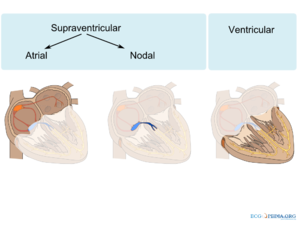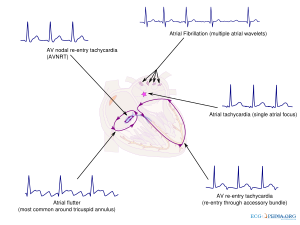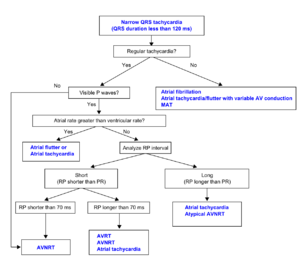Supraventricular Rhythms: Difference between revisions
Jump to navigation
Jump to search
No edit summary |
mNo edit summary |
||
| (42 intermediate revisions by 10 users not shown) | |||
| Line 1: | Line 1: | ||
[[ | {{authors| | ||
|mainauthor= [[user:Drj|J.S.S.G. de Jong]] | |||
|moderator= [[user:Drj|J.S.S.G. de jong]] | |||
|supervisor= | |||
}} | |||
===Supraventricular tachycardias=== | |||
{| class="wikitable" border="1" width="610px" | |||
|- | |||
| [[Image:atrial_ventricular.png|300px]] | |||
| [[image:SVT_overview.svg|300px]] | |||
| [[Image:Svt_algorythm_en.png|300px]] | |||
|- | |||
!Arrhythmias are categorized into supraventricular and ventricular depending on their origin (below the bifurcation of the His bundle is ventricular) | |||
!An overview of pathological supraventricular arrhythmias and their origin | |||
!Algorithm to diagnose SVTs<cite>ACC</cite> | |||
|} | |||
{| class="wikitable" font-size="90%" | {| class="wikitable" font-size="90%" | ||
|- style="text-align:center;background-color:#6EB4EB;" | |- style="text-align:center;background-color:#6EB4EB;" | ||
|+'''An overview of tachycardias''' | |+'''An overview of supraventricular tachycardias''' | ||
|- | |- | ||
! | ! | ||
! | !Example (lead II) | ||
! | !Regularity | ||
! | !Atrial frequency | ||
! | !Ventricular frequency | ||
! | !Origin (SVT/VT) | ||
! | !P-wave | ||
![[Effect of adenosine]] | |||
|- | |- | ||
| colspan="8" style="text-align:left;background-color:#cfefcf;" | '''Narrow complex (QRS<0.12)''' | | colspan="8" style="text-align:left;background-color:#cfefcf;" | '''Narrow complex (QRS<0.12)''' | ||
|- | |- | ||
! [[ | ! [[Sinustachycardia]] | ||
| [[Image:sinustachy_small.svg|200px|Sinustachycardia - a normal p wave precedes every QRS complex]] | |||
| regular | | regular | ||
| 100-180 bpm | | 100-180 bpm | ||
| Line 32: | Line 39: | ||
| gradual slowing | | gradual slowing | ||
|- | |- | ||
! [[ | ! [[Atrial Fibrillation]] | ||
| [[Image:afib_small.svg|200px|Atrial fibrillation - irregular rate, no p waves]] | |||
| grossly irregular | | grossly irregular | ||
| 400-600 bpm | | 400-600 bpm | ||
| Line 40: | Line 48: | ||
| slows down rate; irregularity remains | | slows down rate; irregularity remains | ||
|- | |- | ||
! [[ | ! [[Atrial Flutter]] | ||
| [[Image:aflutt_small.svg|200px|Atrial flutter - sawtooth in lead II with 2:1 block]] | |||
| regular (sometimes alternating block) | | regular (sometimes alternating block) | ||
| 250-350 bpm | | 250-350 bpm | ||
| Line 48: | Line 57: | ||
| temporary reduced conduction (e.g. 4:1) | | temporary reduced conduction (e.g. 4:1) | ||
|- | |- | ||
! [[ | ! [[AVNRT]] | ||
| [[Image:avnrt_small.svg|200px|ANVRT - rSR' in lead V1]] | |||
| regular | | regular | ||
| 180-250 bpm | | 180-250 bpm | ||
| Line 56: | Line 66: | ||
| stops | | stops | ||
|- | |- | ||
! [[ | ! [[Atrial Tachycardia]] | ||
| [[Image:atrialtachy_small.svg|200px|Atrial tachycardia - like sinustachycardia but the p wave has a different morphology]] | |||
| regular | | regular | ||
| 120-250 bpm | | 120-250 bpm | ||
| Line 64: | Line 75: | ||
| temporary AV-block | | temporary AV-block | ||
|- | |- | ||
! [[ | ! [[AVRT|Atrio-Ventricular Reentry Tachycardia (AVRT)- orthodromic]] | ||
| [[Image:avrt_small.svg|200px|AVRT - inverted p wave behind every QRS complex]] | |||
| regular | | regular | ||
| 150-250 bpm | | 150-250 bpm | ||
| Line 72: | Line 84: | ||
| stops | | stops | ||
|- | |- | ||
! [[ | ! [[AVJT|AV junctional tachycardia]] | ||
| [[Image:avnodal_small.svg|200px|AV junctional tachycardia - no or inverted p-waves within QRS complex]] | |||
| regular | | regular | ||
| 60-100 bpm | | 60-100 bpm | ||
| Line 79: | Line 92: | ||
| RP < PR | | RP < PR | ||
| reduces rate | | reduces rate | ||
|- | |||
| colspan="8" style="text-align:left;background-color:#cfefcf;" | '''Wide complex (QRS>0.12)''' | |||
|- | |||
! [[Supraventricular tachycardia with block]] | |||
| [[Image:atrial_tachy_with_LBBB_leadII.svg|200px|SVT with block - any SVT combined with LBBB or RBBB]] | |||
| (ir)regular depending on SVT | |||
| 100-250 bpm | |||
| 75-200 bpm | |||
| atria (SVT) | |||
| absent | |||
| temporary increased AV-block (eg 4:1) | |||
|- | |||
! [[AVRT|Atrio-ventricular Reentry Tachycardia (AVRT) - antidrome]] | |||
| | |||
| regular | |||
| 150-250 bpm | |||
| 150-250 bpm | |||
| circular: bypass - atria - av-node - ventricles | |||
| RP < PR | |||
| stops | |||
|- | |- | ||
|} | |} | ||
{{Box| | |||
===Supraventricular [[Ectopic Beats|ectopic beats]]=== | |||
*[[Atrial Premature Complexes]] | |||
*[[Wandering Pacemaker]] | |||
*[[AV-nodal complexes]] | |||
}} | |||
{{Box| | |||
===Also read=== | |||
*[[Introduction to Arrhythmias]] | |||
*[[Mechanisms of Arrhythmias]] | |||
*[[Sinus node rhythms and arrhythmias]] | |||
*[[Junctional Tachycardias]] | |||
*[[Ventricular Arrhythmias]] | |||
}} | |||
{{Box| | |||
==References== | |||
<biblio> | |||
#ACC pmid=14563598 | |||
</biblio> | |||
}} | |||
[[Category:ECG Textbook]] | |||
Latest revision as of 19:09, 23 August 2011
| Author(s) | J.S.S.G. de Jong | |
| Moderator | J.S.S.G. de jong | |
| Supervisor | ||
| some notes about authorship | ||
Supraventricular tachycardias
| Example (lead II) | Regularity | Atrial frequency | Ventricular frequency | Origin (SVT/VT) | P-wave | Effect of adenosine | |
|---|---|---|---|---|---|---|---|
| Narrow complex (QRS<0.12) | |||||||
| Sinustachycardia | regular | 100-180 bpm | 100-180 bpm | sinusnode (SVT) | precedes every QRS complex | gradual slowing | |
| Atrial Fibrillation | grossly irregular | 400-600 bpm | 75-175 bpm | atria (SVT) | absent | slows down rate; irregularity remains | |
| Atrial Flutter | regular (sometimes alternating block) | 250-350 bpm | 75-150 bpm (3:1 or 2:1 block is most common) | atria (SVT) | negative sawtooth in lead II | temporary reduced conduction (e.g. 4:1) | |
| AVNRT | regular | 180-250 bpm | 180-250 bpm | AV-node (SVT) | in QRS complex (R') | stops | |
| Atrial Tachycardia | regular | 120-250 bpm | 75-200 bpm | atria | precedes QRS, p wave differs from sinus-p | temporary AV-block | |
| Atrio-Ventricular Reentry Tachycardia (AVRT)- orthodromic | regular | 150-250 bpm | 150-250 bpm | circle: av-node - ventricles - bypass - atria | RP < PR | stops | |
| AV junctional tachycardia | regular | 60-100 bpm | 70-130 bpm | AV node | RP < PR | reduces rate | |
| Wide complex (QRS>0.12) | |||||||
| Supraventricular tachycardia with block | (ir)regular depending on SVT | 100-250 bpm | 75-200 bpm | atria (SVT) | absent | temporary increased AV-block (eg 4:1) | |
| Atrio-ventricular Reentry Tachycardia (AVRT) - antidrome | regular | 150-250 bpm | 150-250 bpm | circular: bypass - atria - av-node - ventricles | RP < PR | stops | |
Supraventricular ectopic beats
{{{1}}}


